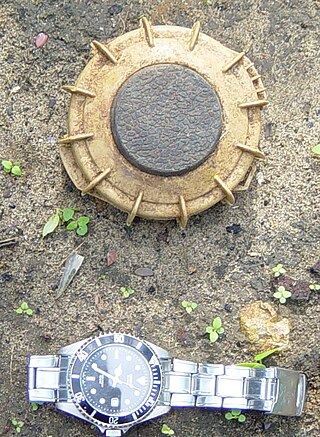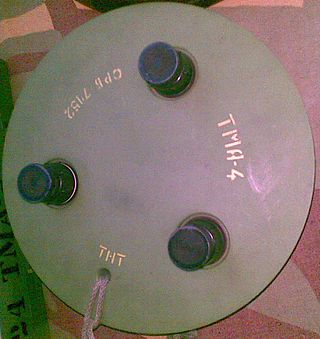Type 72 Non-Metallic is a Chinese circular, plastic bodied landmine which is designed to damage or destroy a vehicle by blast effect.

The TM-46 mine is a large, circular, metal-cased Soviet anti-tank mine. It uses either a pressure or tilt-rod fuze, which is screwed into the top. Anti-tank mines with this type of fuze were capable of inflicting much more damage to armored vehicles, when compared to a typical anti-personnel mine.

The PMN series of blast anti-personnel mines were designed and manufactured in the Soviet Union. They are one of the most widely used and commonly found devices during demining operations. They are sometimes nicknamed "black widow" because of their dark casings.

The M15 mine is a large circular United States anti-tank blast mine, first deployed during the Korean War. Essentially, it is a larger version of the M6A2 anti-tank mine, which it replaced. Although the M15 has been superseded by the M19 mine, the U.S. retains large stocks of M15s because they are still regarded as reliable and effective weapons. When used against main battle tanks the M15 is primarily a "track-breaker" which creates mobility kills, but has a comparatively small likelihood of causing crew fatalities. However, when used against light vehicles such as APCs or unarmored vehicles such as trucks the damage it can inflict is much more severe.

The VS-1.6 is an Italian circular plastic-cased scatterable anti-tank blast mine. It has very few metal components and is resistant to overpressure and shock. The mine can also be deployed conventionally and from helicopters. It was produced by Valsella Meccanotecnica, but production has ceased.

The VS-50 is a circular plastic-cased anti-personnel blast mine that entered production in 1985. It was formerly made by the now-defunct Valsella Meccanotecnica SpA, an Italian high-tech defence company specialized in area denial systems. The company also the made the Valmara 69, and was one of the first to implement plastic construction for landmines. The VS-50's design is similar to that of the TS-50 and VS-MK2 mines. It is blast resistant and can be used in a minimum metal configuration. Though unlikely to kill, its explosive charge is quite sufficient to destroy the victim's foot, being capable of penetrating 5 mm of mild steel leaving an 80 mm-diameter hole.

The TC/3.6 and TC/6 are round minimum metal Italian anti-tank blast mines. Both mines use the same fuzing system. They have round deep ribbed plastic cases that are either sand colored or olive green. The fuze works on an air pressure system, with the top pressure plate forcing air through a small bleed valve. The air then inflates a diaphragm which indirectly applies force to the striker spring until a steel restraining ball is forced out of the way of the striker. The striker is then flipped into the detonator, triggering the mine.
The SB-81 is an Italian plastic cased minimum metal anti-tank blast mine dating from the early 1980s. The mine uses an air pressure based fuze, which gives it protection against overpressure and blast. It can therefore be regarded as a blast resistant mine. The mine can be scattered by hand or by mine laying systems.
The M6, M6A1 and M6A2 are a series of metal-cased, circular, heavy anti-tank landmines produced by the United States from May 1944 to May 1945.

The TMA-2 is a rectangular plastic cased Yugoslavian minimum metal anti-tank blast mine. It is very similar in appearance and size to the PT-56, which it replaced. The mine consists of two sections, an upper ribbed pressure plate with two large circular fuze caps, and a lower base section containing the main charge and two primary fuze wells containing UANU-1 fuzes. A secondary fuze well is provided in the base of the mine for an anti-handling device.

The TMA-3 is a circular Yugoslavian minimum metal anti-tank blast mine. It is very similar in appearance to the TMA-4. The mine consists of a cast circular block of explosive cased in resin reinforced fabric. The top of the mine has three fuze wells which each take a UTMA-3 fuze, and a fourth secondary fuze well is provided in the base of the mine to fit an anti-handling device. The fuze wells may also accept a number of other fuzes, including the UPROM-1, and other fuzes, potentially allowing tripwire activation. The small pressure plate area of the UTMA-3 fuzes gives the mine good resistance to minefield clearance techniques which used blast overpressure techniques i.e. explosive charges.

The TMA-4 is a circular plastic cased Yugoslavian minimum metal anti-tank blast mine. It is a modernized version of the TMA-3. The mine is basically a cast block of TNT with three fuze wells cut into it, encased in plastic. Three black plastic UTMA-4 fuzes are installed into the top surface of the mine. A thin rope carry handle is also provided. The small pressure plate area of the fuzes make the mine resistant to overpressure from explosive demining techniques. Additionally the low metal content of the mine make it very difficult to detect. Although no secondary fuze well is provided, it is possible that the mine could be fitted with improvised anti-handling devices.
The SBP-04 and SBP-07 are two circular Italian minimum metal anti-tank blast mines. The mines are very similar, differing only in the size of the main charge. The mines have a central raised pressure plate a fuze assembly, similar to the SH-55. They are waterproof and are non-buoyant, and have a shelf life of ten years.
The NR 25 is a circular Dutch steel cased anti-tank blast mine. It is broadly similar in appearance to the German Tellermine 43, although it is larger. The mine has a central domed pressure plate, underneath which is an NR-29 mechanical pressure fuze, which is inserted into a fuze well. A doughnut-shaped main charge surrounds a central booster charge. Two secondary fuze wells are provided on the side and base of the mine, for anti-handling devices.
The M 51 MACI and M 52 MACI are French circular minimum metal anti-tank blast mines. The use a variety of fuzes, a M61 pressure/friction fuze, a "tentacle" fuze with four hoses that triggers the mine when two of the opposite tentacles are crushed, and a tilt rod fuze. The M51 and M52 are broadly similar with a thin fibreglass cases, the principal difference being the M52 is slightly larger than the M51.

The TM-38 was a rectangular, metal-cased Soviet anti-tank mine used during the Second World War. The mine had a large raised rectangular central pressure plate with four reinforcing creases. When enough pressure was applied to the plate it collapses pressing down on a bolt connected to an internal lever. The lever pulls a retaining pin from the MUV fuze, which releases the striker, which impacts the MD-2 detonator.

The FFV 028 is a series of steel cased Swedish anti-tank mines that use electronic fuzes. The mines are circular, with a large Misznay Schardin effect warhead in the center of the mine, with the fuzing and sensor electronics located in the dead space above the main charge. The design of the mine dates from the 1970s and uses a magnetic influence sensor to detonate the mine, making it able to attack the full width of armoured vehicles.
The VS-HCT series of mines are Italian plastic cased anti-tank mines that use Misznay Schardin effect warheads and have a dual seismic and magnetic fuze. The mines are no longer produced and differ in size and shape.
The VAR/40, VAR/100 and VAR/100/SP are Italian anti-personnel blast landmines produced by the Tecnovar italiana S.p.A. company.

The TS-50 is a 90 mm (3.5 in) diameter circular Italian blast resistant minimum metal anti-personnel mine designed and produced by Valsella Meccanotecnica (Italy).













